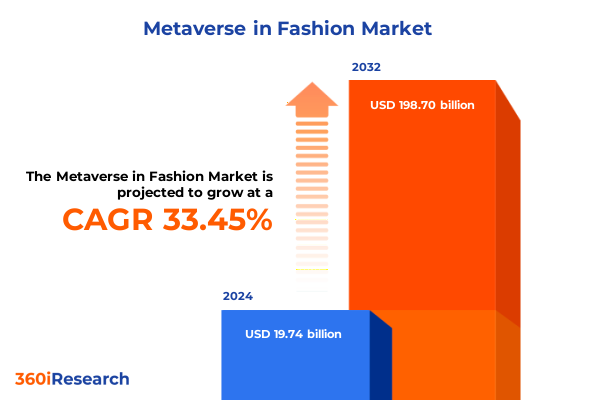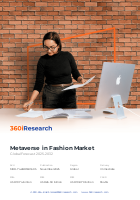The Metaverse in Fashion Market size was estimated at USD 19.74 billion in 2024 and expected to reach USD 26.30 billion in 2025, at a CAGR of 33.45% to reach USD 198.70 billion by 2032.

Setting the Stage for the Fashion Metaverse: Immersive Digital Worlds Converge with Brand Experiences and Consumer Engagement in 2025
The fashion industry is undergoing a paradigm shift as it embraces the immersive potential of metaverse technologies, blending virtual environments with real-world retail and brand experiences. At its core, this transformation is driven by consumer demand for deeper engagement and novel forms of self-expression beyond physical wardrobes. Leading luxury houses and emerging labels alike are pioneering new ways to captivate audiences through digital wearables, avatar customization, and interactive brand worlds that extend the shopping journey into uncharted digital realms. Moreover, advances in hardware, from high-fidelity VR headsets to lightweight AR-enabled glasses, are making these experiences more accessible to mainstream consumers, setting the stage for a sustained evolution of fashion in the virtual sphere
Unveiling the Transformative Shifts Driving Fashion’s Metaverse Evolution from Virtual Wearables to Phygital Ecosystems and AI Integration
As the fashion and tech landscapes converge, transformative shifts are redefining what it means to design, market, and sell apparel and accessories. The rise of augmented reality overlays and virtual reality showrooms has shifted consumer expectations, making immersive try-on experiences and phygital activations foundational elements of modern retail strategies. Brands are leveraging generative AI to create hyper-realistic product visualizations and personalized style recommendations, while blockchain-based digital product passports ensure authenticity and traceability across both physical and virtual channels. These innovations are complemented by a renewed focus on humanizing digital touchpoints-seamlessly blending AI-driven automation with curated, experience-led activations that resonate emotionally with consumers. This fusion of cutting-edge technology and experiential storytelling is empowering brands to cultivate community-driven ecosystems, driving deeper loyalty and unlocking new monetization pathways
Examining the Cumulative Impact of United States Tariffs on Fashion Metaverse Technologies, Supply Chains, and Consumer Prices in 2025
The United States’ tariff environment in 2025 is reshaping the economics of metaverse-driven fashion initiatives, as both hardware and software components encounter elevated import duties. With average import tariffs rising to levels unseen in decades, the cost of high-performance VR headsets, motion-tracking sensors, and haptic devices has increased by up to 25%, placing pressure on consumer pricing models and enterprise deployments alike. These fiscal measures have also spurred brands to diversify supply chains, exploring tariff-exempt sourcing regions and accelerating the development of web-based virtual experiences that reduce reliance on specialized hardware. At the same time, luxury and sportswear labels with domestic manufacturing footprints are partially mitigating these headwinds; however, the broader ecosystem of virtual marketplaces and avatar-based commerce continues to navigate higher production and distribution costs. Collectively, these factors underscore the critical need for agile strategies that balance innovation ambitions with fiscal realities in an unpredictable trade landscape
Revealing Key Segmentation Insights across Components, Technologies, Applications, End Users, and Deployment Modes Shaping the Fashion Metaverse Landscape
The metaverse in fashion encompasses distinct segments that define its complexity and growth trajectories. On the component side, hardware innovations-such as AR glasses and VR headsets-work in concert with specialized services, ranging from managed content delivery to professional integration and support. Underpinning these experiences, software platforms facilitate 3D visualization pipelines, enabling designers and consumers to interact with digital garments in real time. Technological segmentation reveals a spectrum of modalities from augmented and mixed reality overlays to fully immersive virtual reality environments, each offering unique value propositions. When examining applications, virtual clothing collections, immersive events, digital marketplaces, and storefronts serve as primary touchpoints, allowing brands to monetize digital assets and engage global audiences. End-user segmentation highlights diverse adoption patterns, from individual consumers seeking personalized experiences to luxury and mass-market brands leveraging immersive channels for brand building and revenue diversification. Finally, deployment considerations split between cloud-based architectures that ensure scalability and on-premises solutions optimized for data privacy and bespoke enterprise requirements. Together, these segments offer a comprehensive framework to understand where investment, innovation, and differentiation are most impactful within the fashion metaverse ecosystem.
This comprehensive research report categorizes the Metaverse in Fashion market into clearly defined segments, providing a detailed analysis of emerging trends and precise revenue forecasts to support strategic decision-making.
- Component
- Technology
- Application
- End User
- Deployment Mode
Illuminating Key Regional Insights into How the Americas, Europe Middle East Africa, and Asia Pacific Are Driving the Fashion Metaverse Revolution
Regional dynamics play a pivotal role in shaping the global trajectory of metaverse-enabled fashion. In the Americas, North American brands are leading with substantial investments into immersive storefront prototypes and digital wearables backed by robust creative talent pools and high consumer tech adoption, while Latin American designers increasingly harness virtual events to reach international audiences. Across Europe, the Middle East, and Africa, a storied luxury heritage fosters early adoption of digital couture, with established houses experimenting in NFT auctions and phygital runway showcases; regulatory frameworks around data protection and digital assets are influencing deployment strategies, prompting a rise in hybrid models that balance innovation with compliance. In the Asia-Pacific region, user engagement metrics consistently outperform other markets, driven by mobile-first metaverse integrations and social commerce platforms that embed digital fashion as core buying experiences; markets such as China, South Korea, and Japan are at the forefront of AR-enhanced retail concepts and community-driven brand activations, while emerging Southeast Asian hubs deploy localized content strategies to capture rapidly expanding digital audiences
This comprehensive research report examines key regions that drive the evolution of the Metaverse in Fashion market, offering deep insights into regional trends, growth factors, and industry developments that are influencing market performance.
- Americas
- Europe, Middle East & Africa
- Asia-Pacific
Profiling Leading Companies Driving Innovation and Growth in the Fashion Metaverse from Luxury Houses to Technology Powerhouses Shaping Digital Style
A diverse array of companies is shaping the metaverse fashion frontier, ranging from established luxury powerhouses to technology innovators. Iconic fashion brands such as Gucci and Louis Vuitton have leveraged platforms like Roblox and The Sandbox to launch virtual gardens and digital mansions, attracting millions of visitors and propelling brand engagement to new heights. Simultaneously, sportswear leaders including Nike and Adidas are pioneering digital collectible drops and avatar apparel through partnerships with blockchain protocols to tokenize limited-edition designs. Technology giants such as Meta Platforms and Snap Inc. continue to refine AR smart glasses and immersive social experiences, while specialized metaverse developers like Roblox Corp. and Unity Technologies provide the infrastructure that powers virtual environments and creative toolkits. Further driving this convergence, consumer electronics leaders such as Apple are integrating AR capabilities into mainstream hardware, broadening the addressable market for metaverse-powered fashion. Collectively, these stakeholders underscore the collaborative ecosystem needed to deliver seamless and engaging virtual fashion experiences.
This comprehensive research report delivers an in-depth overview of the principal market players in the Metaverse in Fashion market, evaluating their market share, strategic initiatives, and competitive positioning to illuminate the factors shaping the competitive landscape.
- Roblox Corporation
- Meta Platforms, Inc.
- Epic Games, Inc.
- NVIDIA Corporation
- Unity Software Inc.
- Microsoft Corporation
- Adobe Inc.
- Nike, Inc.
- adidas AG
- Animoca Brands Corporation Limited
Delivering Actionable Recommendations for Industry Leaders to Harness Metaverse Technologies, Optimize Strategies, and Build Sustainable Competitive Advantage
Industry leaders must adopt multifaceted strategies to capitalize on the metaverse’s potential while mitigating emerging challenges. First, forging strategic partnerships with technology vendors and platform providers can accelerate time-to-market for immersive experiences and ensure interoperability across ecosystems. Second, brands should invest in scalable content creation pipelines that leverage AI-driven design tools and procedural generation, enabling agile digital product lifecycles and cost efficiencies. Third, developing robust digital asset and community governance frameworks will build consumer trust, particularly in areas like NFT authenticity, secondary-market transactions, and data privacy. Fourth, to counterbalance tariff-induced cost pressures, organizations should explore on-shore and tariff-exempt component sourcing, while simultaneously accelerating web-based metaverse applications to reduce dependence on specialty hardware. Finally, embedding sustainability principles-such as traceable digital twins and eco-friendly virtual activations-will resonate with conscious consumers and reinforce brand credibility in an era of heightened environmental scrutiny
Outlining the Robust Research Methodology Employed to Analyze the Fashion Metaverse Market Including Data Sources, Segmentation, and Validation Frameworks
This research integrates a rigorous blend of qualitative and quantitative methodologies to ensure comprehensive coverage and robust insights. Primary data was gathered through in-depth interviews with senior executives from leading fashion brands, technology providers, and industry experts, providing firsthand perspectives on strategic priorities and innovation roadmaps. Secondary research included the analysis of reputable industry publications, technology white papers, financial disclosures, and regulatory filings to map historical developments and emerging trends. Segmentation analyses were conducted across component, technology, application, end-user, and deployment dimensions, supported by cross-validation with real-world case studies from global market leaders. Regional insights were developed through localized expert consultations and macroeconomic indicators, accounting for regulatory frameworks and consumer adoption patterns. Finally, all findings underwent peer review and triangulation processes to ensure accuracy, relevance, and practical applicability for strategic decision-making.
This section provides a structured overview of the report, outlining key chapters and topics covered for easy reference in our Metaverse in Fashion market comprehensive research report.
- Preface
- Research Methodology
- Executive Summary
- Market Overview
- Market Insights
- Cumulative Impact of United States Tariffs 2025
- Cumulative Impact of Artificial Intelligence 2025
- Metaverse in Fashion Market, by Component
- Metaverse in Fashion Market, by Technology
- Metaverse in Fashion Market, by Application
- Metaverse in Fashion Market, by End User
- Metaverse in Fashion Market, by Deployment Mode
- Metaverse in Fashion Market, by Region
- Metaverse in Fashion Market, by Group
- Metaverse in Fashion Market, by Country
- Competitive Landscape
- List of Figures [Total: 30]
- List of Tables [Total: 507 ]
Concluding Perspectives on the Future Trajectory of Fashion’s Metaverse Convergence Highlighting Strategic Imperatives for Brands and Stakeholders
The metaverse represents a transformative frontier for the fashion industry, offering unprecedented avenues for consumer engagement, brand storytelling, and revenue diversification. As immersive technologies mature, forward-looking brands that balance innovation with operational pragmatism will gain sustainable competitive advantages. The convergence of hardware, software, and service ecosystems underscores the need for collaborative partnerships, flexible deployment models, and governance standards that safeguard authenticity and consumer trust. Regional nuances-from luxury heritage in Europe to social commerce in Asia-Pacific-underscore the importance of localized content strategies and regulatory adaptability. Ultimately, success in the fashion metaverse will hinge on the ability to seamlessly integrate digital and physical experiences, embrace iterative experimentation, and embed sustainability across all touchpoints, ensuring that brands remain relevant and resilient in a rapidly evolving digital marketplace.
Take the Next Step Toward Driving Fashion Innovation in the Metaverse by Engaging with Associate Director Ketan Rohom to Acquire the Detailed Market Report Today
For a comprehensive understanding of the opportunities that lie ahead in fashion’s most dynamic frontier, secure your copy of the full Market Research Report today. Engage directly with Ketan Rohom, Associate Director of Sales & Marketing, to explore tailored insights and customized solutions that will empower your organization to lead in the metaverse era. Contact Ketan to discuss how this in-depth analysis can inform your strategic roadmap, support investment decisions, and unlock new revenue streams through immersive digital experiences. Don’t miss the chance to transform your approach to fashion, technology, and consumer engagement-reach out now to acquire your definitive guide to the Metaverse in Fashion market.

- How big is the Metaverse in Fashion Market?
- What is the Metaverse in Fashion Market growth?
- When do I get the report?
- In what format does this report get delivered to me?
- How long has 360iResearch been around?
- What if I have a question about your reports?
- Can I share this report with my team?
- Can I use your research in my presentation?




